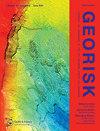Probabilistic Tsunami Hazard Analysis for Vancouver Island Coast Using Stochastic Rupture Models for the Cascadia Subduction Earthquakes
IF 4.8
3区 工程技术
Q1 ENGINEERING, GEOLOGICAL
Georisk-Assessment and Management of Risk for Engineered Systems and Geohazards
Pub Date : 2023-06-21
DOI:10.3390/geohazards4030013
引用次数: 0
Abstract
Tsunami hazard analysis is an essential step for designing buildings and infrastructure and for safeguarding people and assets in coastal areas. Coastal communities on Vancouver Island are under threat from the Cascadia megathrust earthquakes and tsunamis. Due to the deterministic nature of current megathrust earthquake scenarios, probabilistic tsunami hazard analysis has not been conducted for the coast of Vancouver Island. To address this research gap, this study presents a new probabilistic tsunami hazard model for Vancouver Island from the Cascadia megathrust subduction events. To account for uncertainties of the possible rupture scenarios more comprehensively, time-dependent earthquake occurrence modeling and stochastic rupture modeling are integrated. The time-dependent earthquake model can capture a multi-modal distribution of inter-arrival time data on the Cascadia megathrust events. On the other hand, the stochastic rupture model can consider variable fault geometry, position, and earthquake slip distribution within the subduction zone. The results indicate that the consideration of different inter-arrival time distributions can result in noticeable differences in terms of site-specific tsunami hazard curves and uniform tsunami hazard curves at different return period levels. At present, the use of the one-component renewal model tends to overestimate the tsunami hazard values compared to the three-component Gaussian mixture model. With the increase in the elapsed time since the last event and the duration of tsunami hazard assessment, the differences tend to be smaller. Inspecting the regional variability of the tsunami hazards, specific segments of the Vancouver Island coast are likely to experience higher tsunami hazards due to the directed tsunami waves from the main subduction zone and due to the local underwater topography.基于卡斯卡迪亚俯冲地震随机破裂模型的温哥华岛海岸海啸灾害概率分析
海啸危害分析是设计建筑物和基础设施以及保护沿海地区人员和财产安全的重要步骤。温哥华岛的沿海社区正受到卡斯卡迪亚大断层地震和海啸的威胁。由于目前大逆冲地震情景的确定性,尚未对温哥华岛海岸进行概率海啸危害分析。为了弥补这一研究空白,本文从卡斯卡迪亚大逆冲俯冲事件出发,提出了一种新的温哥华岛海啸灾害概率模型。为了更全面地考虑可能的破裂情景的不确定性,将随时间的地震发生模型和随机破裂模型相结合。时间相关地震模型可以捕捉到卡斯卡迪亚大逆冲事件到达时间间数据的多模态分布。另一方面,随机破裂模型可以考虑在俯冲带内变化的断层几何形状、位置和地震滑动分布。结果表明,考虑不同的到达间时间分布,不同回归期水平下的特定地点海啸灾害曲线和均匀海啸灾害曲线存在显著差异。目前,与三分量高斯混合模型相比,使用单分量更新模型容易高估海啸危害值。随着最后一次海啸发生后的时间和海啸灾害评估持续时间的增加,这种差异趋于缩小。从海啸灾害的区域变异性来看,温哥华岛海岸的特定区域由于受到来自主俯冲带的定向海啸波和当地水下地形的影响,可能会经历更高的海啸灾害。
本文章由计算机程序翻译,如有差异,请以英文原文为准。
求助全文
约1分钟内获得全文
求助全文
来源期刊
CiteScore
8.70
自引率
10.40%
发文量
31
期刊介绍:
Georisk covers many diversified but interlinked areas of active research and practice, such as geohazards (earthquakes, landslides, avalanches, rockfalls, tsunamis, etc.), safety of engineered systems (dams, buildings, offshore structures, lifelines, etc.), environmental risk, seismic risk, reliability-based design and code calibration, geostatistics, decision analyses, structural reliability, maintenance and life cycle performance, risk and vulnerability, hazard mapping, loss assessment (economic, social, environmental, etc.), GIS databases, remote sensing, and many other related disciplines. The underlying theme is that uncertainties associated with geomaterials (soils, rocks), geologic processes, and possible subsequent treatments, are usually large and complex and these uncertainties play an indispensable role in the risk assessment and management of engineered and natural systems. Significant theoretical and practical challenges remain on quantifying these uncertainties and developing defensible risk management methodologies that are acceptable to decision makers and stakeholders. Many opportunities to leverage on the rapid advancement in Bayesian analysis, machine learning, artificial intelligence, and other data-driven methods also exist, which can greatly enhance our decision-making abilities. The basic goal of this international peer-reviewed journal is to provide a multi-disciplinary scientific forum for cross fertilization of ideas between interested parties working on various aspects of georisk to advance the state-of-the-art and the state-of-the-practice.

 求助内容:
求助内容: 应助结果提醒方式:
应助结果提醒方式:


